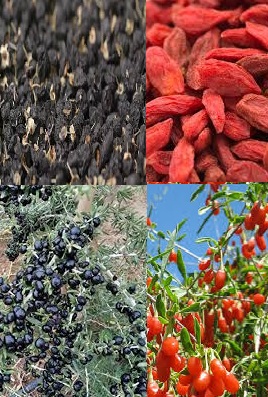 |
| Ginkgo seeds from Kashmir |
POB 667 GPO Srinagar SGR JK 190001
Mob: 09858986794/9419966983
WhatsApp : 9858986794
Ph: 01933-223705
e-mail: jkmpic@gmail.com
 |
| Ginkgo seeds from Kashmir |
 |
| Gojiberry plantation گوجی بیری |
Goji, goji berry, or wolfberry is the fruit of either the Lycium barbarum or Lycium chinense, two closely related species of boxthorn in the nightshade family, Solanaceae.
The goji berry, also called the wolfberry, is a bright orange-red berry that comes from a shrub that's native to China. In Asia, goji berries have been eaten for generations in the hope of living longer.
The Jammu and Kashmir Medicinal Plants Introduction Centre, was established under the Fruit & Medicinal plants Development Project during the year 2020-2011. The infrastructure, existing as on date, was created over a period of 5-10 years. 
Ginkgo plants for sale
 |
| Fruit plants of Kashmir |
 |
| Persimmon tea Kashmir |
Physalis peruviana, a plant species of the genus Physalis, is originally from Peru. The plant and its fruit are most commonly known as Cape gooseberry (South Africa, Kashmir, UK, Australia, China, Pakistan,Iran, India, New Zealand), or Physalis-(Inka Berry.
 |
| Angelica herbal seeds |
 |
| Gojiberry trees in Kashmir |
The annual yield from Goji berry fruits during its third year is about 2200-2500 kg/ha of dried fruits, and 4000-4500 kg/ha dry fruits during the fifth year. It is recommended to plant Goji with density from 3500 plants per hectare (1.60m between plants with a row spacing of 1.80m). The plants have to be adapted and stabilized before planting in field. Maximum yields of as high as 7500kg of fresh fruit per hectare have been reported in China.
Commercial growing- Yields
Spacing
Planting of Goji is performed during spring or the summer. Before planting, the land must be levelled, cultivated and marked. When developing large scale plantations with machine cultivation, it is recommended to use a plant spacing of 1.3m – 1.8m and 1.8 – 2.5m for spacing between the rows. For small plantations and home gardens, the distance is shortened up to 1.0 between plants and 1.5m between the rows.
Newly planted plants should be kept moist until they are established and well leafed out. Thereafter they become can become very drought hardy and require little water.
A planning hole can be made at a size of 30cm x 30cm x30cm.
In general, good quality compost or well rotted manure (1.0-2.0kg) and a small hand full of bone meal (about 30g) can be added to the bottom of the planting hole, but make sure to backfill the hole a bit with the sandy soil in order for the roots not to touch the compost/manure. There are also good organic complete fertilizers on the market such as the VitaGrow 2:3:2 from Talborne Organics which works well to add to the planting hole before planting. Care must be taken to follow the application directions as too much fertilizer can burn the roots.
Availability of Seed/planting material
Jammu and Kashmir Medicinal Plants Introduction Centre
 |
| Taxus baccata tree seeds in kashmir |
It is extracted from the berries, leaves and seeds of the Sea buckthorn/Sindberry plant (Hippophae rhamnoides), which is a small shrub that grows at high altitudes in the Kashmir region.Sometimes referred to as the holy fruit of the Himalayas, sea buckthorn can be applied to the skin or ingested.
 |
| Heeng Seeds |
Ginkgo Gulzar : Reviving Herbal Medicine for the Modern World The phrase could represent a general concept or idea related to the medicinal...
